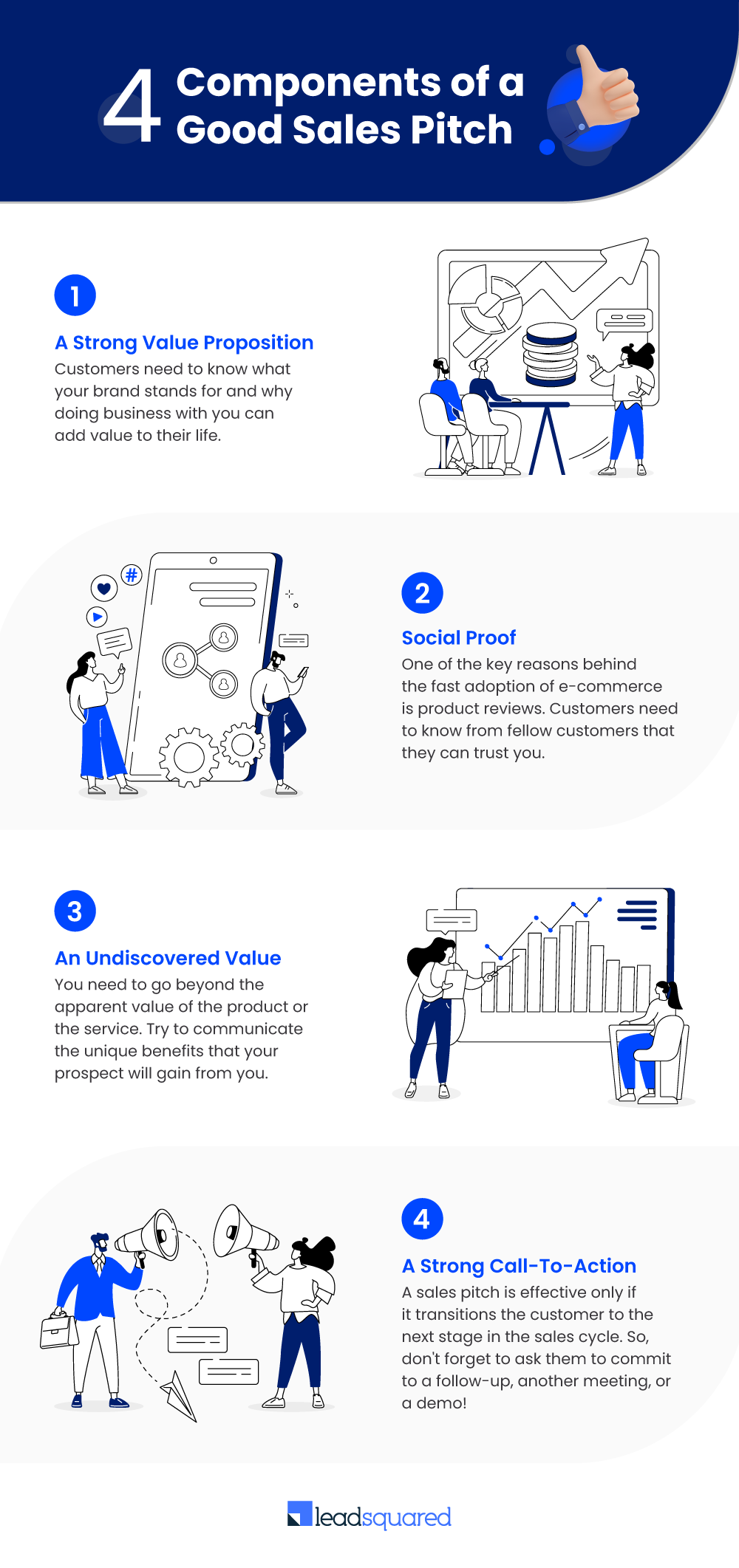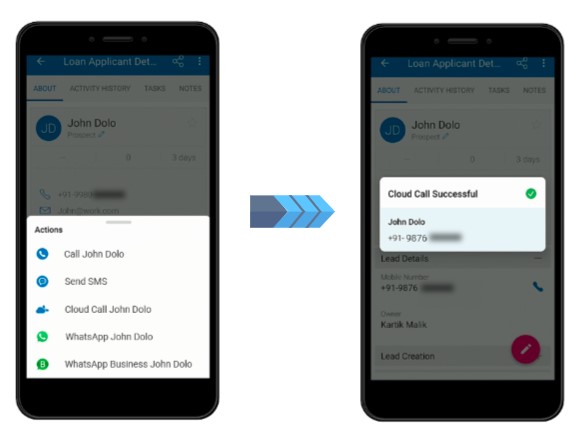We live in an attention economy.
Every content we come across is an advertisement or has an advertisement in it.
No wonder why people feel overwhelmed and interrupted when approached to sell a product/service.
Amidst this, how do you make your sales pitch stand out from the crowd?
Read on to find out.
What is a sales pitch?
A sales pitch is a compact presentation of your product/service to the buyer. The purpose of a sales pitch is to invite a conversation and not necessarily to sell the product. Ideally, the pitch should not take more than a couple of minutes. Sales pitches are also called elevator pitches for this reason – they should be as short as an elevator ride.
A good sales pitch must have the following four components:

A proficient salesperson also knows the value of time and should get the message across as concisely as possible. If the prospect seems interested, set up a meeting with them.
3 Types of sales pitches that actually work
A sales pitch is all about persuading the client for the next meeting.
You may come across several types of sales pitches, such as an elevator pitch, a follow-up pitch, a Twitter pitch, the Pixar pitch, and the list goes on. But out of these, three pitches work for sure.
Let’s look at them.
1. The question pitch
“When the facts are very strongly on your side in an argument, questions are more persuasive than statements.”
Daniel Pink (via: Masterclass)
A question provokes a thought.
When you ask a question, the person you’re pitching to comes up with their reasons for that question.
And when people have their reasons for doing something, they’re more likely to do it.
Now you may wonder how to use this strategy in your next sales pitch.
It’s simple.
Change your pitch from a statement to an interrogative sentence.
Let’s take an example. You’re in an e-learning business, and you want to influence a parent to buy your yearly subscription for their ward.
A declarative pitch would look like this—this is the best e-learning curriculum in the world. You need it for your child’s future.
Well, now if we spin it to make a question pitch, it will look something like this:
“How much is it worth to you to ensure your child’s future?”
The second pitch is certainly more effective because every parent would care for their children’s future. Their answer would be—I cannot put a price on that. But now they’d be more interested to know about your offering.
2. The rhyming pitch
Remember the famous quote from the OJ Simpson murder trial:
“If it (gloves) doesn’t fit, you must acquit!”
Out of all the things in that trial, why do we specifically remember this phrase?
Well, because it rhymes.
Researchers call it rhyme-as-as-reason effect. It is a cognitive bias that makes people more likely to believe statements that contain a rhyme, compared to statements that don’t.
For instance, people think that the statement “woes unite foes” is more accurate than the statements “woes unite enemies” and “misfortunes unite foes,” even though they all mean the same thing.
So, you can also try this technique in your next sales pitch.
You may think that writing catchy phrases is a marketer’s job.
Well, it’s not.
You can make your conversations more interesting by making them rhyme.
Let me give you an example.
When a prospect agrees on something, instead of saying “great” or “cool,” try saying—“John West, you’re the best!” And before you notice, you’ve already reserved a sweet spot in their heart.
3. The Pixar pitch
Pixar gained huge success with its movies like Toy Story, Brave, Finding Nemo, etc. Interestingly, they replicated the same storyline in most of their stories and it worked every time.
Almost all of their narratives follow a similar framework, which comprises of 6 parts:
- Once upon a time…
- Everyday…
- One day…
- Because of that…
- Because of that…
- Until finally…
Now let’s try to use this idea into a sales pitch.
Let’s say, you want to pitch your fitness app. Here’s how it can look like:
“Once upon a time, every 1 in 3 Americans suffered from hypertension, diabetes, and coronary heart disease. Every day, they would pop tens of pills and worry about their declining health conditions.
One day, we realized that the problem isn’t the availability of healthcare. It is the lack of effort people put in to stay fit. So, we decided to build an app that tracks 5 vital health conditions and suggests simple remedies like jogging, drinking water, and exercise.
Because of that more people got control over their health. Because of that they reduced hospital visits and take lesser medicines; until finally, they’re better off at their jobs and are living a happier and healthier life.”
This approach helps you clarify your message. Or, at the very least, it piques interest in a conversation.
So now you know the 3 most effective techniques of writing sales pitches. Let’s see where and how you can pitch your product/services.
How and where should you pitch?
1. Of course, in an elevator
One of the oldest forms of a sales pitch is the elevator pitch. You need to prepare for this form of a sales pitch when you are in networking events or accidentally meet with a prospect for the first time. In such situations, you have about thirty seconds to a minute to make your pitch.
Robert Herjavec, serial entrepreneur and investor on ABC’s Shark Tank, believes that timing and momentum are everything when it comes to winning sales pitches. (via Forbes)
So, to make the most of your pitch in that short span, follow these tips:
- Know your audience. Know who they are and what they care about.
- Use social proof. If you give an example of someone they know, someone they compete with, the better it is.
- Craft a story. Instead of boasting about your achievements, tell a story they could relate to.
- Anticipate and answer key questions in your pitch.
2. On social media
The odds of finding someone in an elevator (or in a networking event) are lesser these days. But, you can, of course, find them on social media.
And you’ll find lots of events to strike a conversation. Funding, new role, new launch, to name some.
Here’s an example pitch when your prospect gets promoted to a new role.
Hey Dan! Many congratulations on the VP-Sales, APAC role! It’s huge. I’m so happy for you, and I’m sure you’ll take your company to new heights.
I’m also curious about what will be your biggest priority in this new role. Can we talk over a cup of coffee sometime?
3. Through cold emails
Emails are still one of the best ways of reaching out to people.
But let’s face it.
An average person receives more than 100 emails in a day! And that too, I’m not considering spam.
So, how do you make your email stand out?
Well, there are two aspects to it.
- Subject line
- Body copy
The purpose of a subject line is to get your email opened. And the email content should be good enough so that the recipient does not regret opening the email.
Here are two tips to make your email subject line effective.
Make sure the subject line has the elements of utility and curiosity. By utility, I mean what you suggest in the email is valuable to the recipient. And by curiosity, I mean the recipient should be intrigued to open the email.
Let’s look at some bad and good examples of email subject lines.
- Ideas – Bad
- 2 More ideas for higher ROI – Good
- A thought – Bad
- A weird idea I thought could work for lead generation – Good
You can also use granular numbers to make your subject lines more effective. Actually, it applies to the email content as well.
- Some more thoughts on our discussion last week – Bad
- 2 More thoughts on our discussion last week – Good
- 2 More thoughts on the budget – Even better
Note the purpose of the subject line is only to get the email opened. Let the email content drive the action.
Here are the tips for writing sales pitch emails.
- Get to the point quickly
- Wrap it up in about 125 words
- Break down the email into three parts: the opener, the pitch, and the call-to-action.
4. Through cold calls
Cold calling is calling up someone out of blues.
It is also one of the most dreaded aspects of sales because the caller often seems like an uninvited guest—disrupting the recipient’s flow of work.
Nonetheless, 82% of buyers agree to meet with sales reps who interact with them through cold calls.
To pitch your product/services over a cold call, follow these steps:
- Introduce yourself
- Ask if they want to continue the conversation for a minute
- Start your pitch
- Close the call with a request for a meeting
Don’t drag the call even if the prospect seems to have time. Also, practice your pitch beforehand so that you don’t fumble or sound less confident.
Here are 25 cold-calling scripts you can practice.
Alright. So, these are the ideas I wanted to discuss about the sales pitch.
I’m 100% sure you’ll benefit from these. But before we wrap up, there’s one more thing I’d like to share with you.
It’s about making the most of your efforts in sales.
What should you do after you’ve pitched your product/services?
After your pitch, the person is no longer a stranger. They’ve become a contact who’s either interested or not interested in further conversations with you. The next obvious thing you should do is—follow up.
Imagine you make 50 cold calls in a day. Or you send emails to thousands of recipients in a day. How do you track their responses?
If you’re doing it on excel sheets or in your diary, I’ll tell you there’s a better way to manage your leads. Use sales CRM software. It helps you:
Create lead records and track all the interactions they have with you/your brand
There are many benefits to it. One, you can add notes, create follow-up reminders, and get notified whenever they show interest in your company (such as opening your email, downloading a whitepaper, checking your pricing page, etc.). And two, other reps in your team will know that you’re pursuing that lead. So, they’ll not chase them.
Make cold calling or cold emailing easy
Usually, companies have a list of contacts they wish to target. SDRs make cold calls and run email campaigns to understand their interest in your products/services. Sales CRM makes it easy to get in touch with prospects. Software, such as LeadSquared, seamlessly integrates with RingCentral, CallTrackingMetrics, and more and offers cloud calling facility through the CRM platform itself. Also, the interaction you had (interested/not interested/demo scheduled/purchase) can be logged in then and there itself—saving time and efforts to record the disposition.

Monitor calls
Sales CRM allows managers to monitor calls and help their team members improve the pitch.
“We integrated LeadSquared with a cloud calling solution from Exotel for all our call centre executives which enabled us to monitor the calls, leading to process monitoring, identifying training needs thus improving on the conversion rates.”
Prabhakar Tiwari, Chief Growth Officer, Angel One
If you want to see how LeadSquared can help you execute sales faster and better, book a demo!








